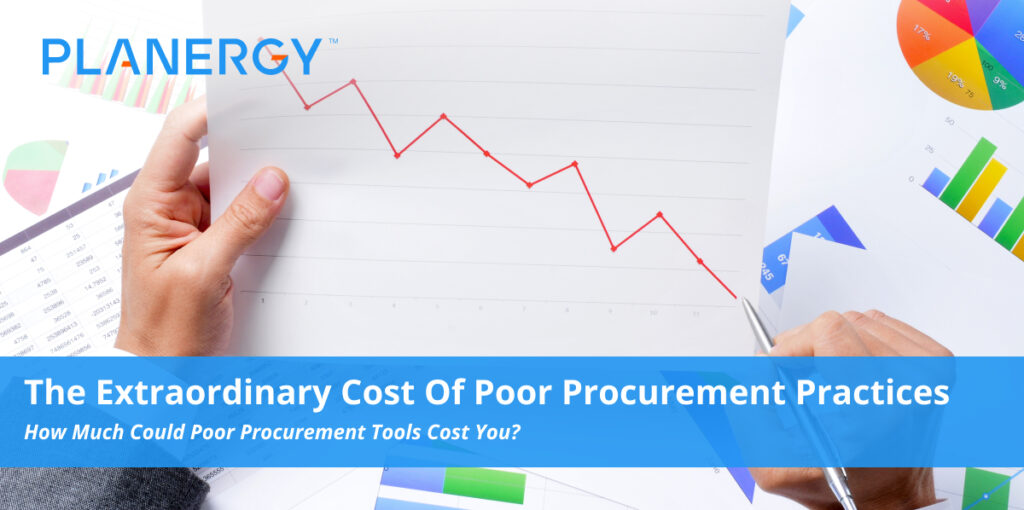Bad procurement processes can impact an organization from liquidity to production.
With profitability, productivity, and even business reputation on the line, poor procurement is far more costly than you may think.
In 2014, The Topline Strategy Group reported that U.S. businesses were wasting more than 32 million man-hours annually by implementing ineffective procurement tools.
Only 28% of the procurement professionals surveyed believed that their procurement system enhanced their productivity.
Although the findings in this report are four years old, organizations are still adapting to change at glacial pace, and losing money as a result.
Global health organization UNICEF, for example, procured a total of $3.46 billion in goods and services last year, and credited savings on their procurement costs of $394.6 million in 2017 to strategic procurement practices, including competitive sourcing and nurturing of partner relationships.
Public Sector Impacts
It’s not only the private sector suffering from poor procurement. A 2015 Deloitte report estimates that with better procurement procedures, the Australian government could save $2.5 billion and boost GDP by an additional $5.1 billion by 2030.
After the Scottish government implemented their first-ever procurement strategy in 2017, they report saving taxpayers almost £160 million, paying 99% of invoices within ten days, and contracting more small and medium Scottish businesses with fair work practices.
As a result, Scotland boosted the economy in several ways, including supporting SMB and fair employment, putting more money back into the economy faster, and saving taxpayer money.
When we take a look at how the United States stack up, one conclusion is unavoidable:
The states that ranked highest for best procurement practices adopted digital technology early and invested in the time and training to use it properly.
Virginia, which boasts one of the most efficient procurement departments, first embraced procurement technology as part of their supply chain in 2001.
Georgia’s stellar procurement team reports that data-driven procurement and cost management saves the state $61 million per year – a cost reduction of 11% of their budget.
We also have less shining examples. Colorado, in a misguided attempt to get on board, implemented a new financial system designed to track money from the initial requisition through the invoice payment.
However, the department chose a complicated system and neglected to invest adequate time in training. The overall result, according to survey respondents, was detrimental.
Choosing a user-friendly system and investing in qualified procurement professionals and a comprehensive training course is critical to success.
Recent reports about U.S. military spending demonstrate how outrageous poor government procurement practices can be.
Fox News recently reported several news stories about overages in military budgets, including $1,220 (each) coffee cups with a tendency to break and $10,000 toilet seat covers purchased by the Air Force, and $64,000 shelled out by the Marines for a radio cable that retails for about $4,000.
Taxpayers can and should be concerned by wasteful spending procedures and lack of accountability in government procurement increasing total procurement costs.
Consequences Far Beyond Costs
In industries where lives are at stake, poor procurement practices can have tragic consequences. On June 14, 2017, a fire broke out in a London apartment building.
Seventy-two people lost their lives and hundreds more were left homeless.
An independent review commissioned by the UK government highlighted how the total cost of the Grenfell Tower disaster was directly related to poor procurement practices.
In the report foreword, Dame Judith Hackitt references “race to the bottom” construction industry culture that lacks structure, strategy, and oversight.
Some of the key system failures leading to the disaster include:
- Ignorance – fundamental misunderstanding leading to non-compliance with regulations.
- Indifference – a gentle word to describe prioritizing quick, cheap construction over quality and safety.
- Lack of clarity on roles and responsibilities – no clear roles are designated, leaving no one accountable.
- Lack of oversight – both within the company and by regulatory agencies.
- Lack of audit trails – no documentation logged to show whether safety work and inspections were completed.
Further details are supplied in Chapter 9. According to the summary, “The procurement process kick-starts the behaviours that we then see throughout design, construction, occupation and maintenance.”
To avoid future disasters, the committee’s advice reads like a primer for procurement best practices and applies to private sector businesses as well.
This advice includes:
- Build robust procurement relationships between the client, designer, contractor, subcontractors, and supplier.
- Use strategic sourcing strategies to identify the best contract value as opposed to the lowest bid. Contracts should be awarded to contractors and subcontractors who deliver the best product at a competitive price and demonstrate the ability to follow safety and quality regulations and requirements.
- Establish clear roles to track accountability.
- Increase process visibility.
- Establish inspection benchmarks and document audit trails.
- Review and evaluate supplier performance to identify emerging issues and leverage improved contract management.
- Define and follow payment terms to foster better relationships and communication with suppliers and contractors. Non-payment can put a financial strain on suppliers, leading them to compromise quality by substituting cheaper raw material.
- Document every stage of the project from tender to sign-off and payment. Establish clear protocols for each stage of the project.
Lower Costs, Minimize Risks, Maximize Efficiency
What all this shows is this: Organizations without a comprehensive procurement strategy and usable software solutions are at risk for poor quality or fraudulent sourcing, budget overruns due to unnecessary man-hours, and unacceptable costs associated with those risks.
Organizations who want to minimize the cost of poor procurement practices should prioritize choosing e-procurement systems that offer ease of use, robust reporting, and audit trails to track purchases from purchase order through delivery and payment.
Most importantly, the system should provide the visibility necessary for accountability and procurement fraud prevention.
This is ensures cost-effective best practices are implemented resulting in reduced transaction costs, increased efficiency, and minimized risk for the long-term.




